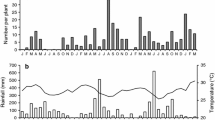Abstract
To determine whether Monochamus alternatus can use the Japanese cedar (Cryptomeria japonica) as a host tree, experiments were conducted in a laboratory using three insect populations of different localities. Adult females chose Pinus densiflora bolts as oviposition substrate when supplied with cedar and pine bolts simultaneously, whereas some females from one locality oviposited on cedar bolts when supplied with them exclusively. Seventy-three percent of 40 eggs hatched in cedar bolts. When the first instar larvae were inoculated on cedar bolts, the development was stunted greatly and all died during the larval stage. Two of 20 larvae that were inoculated on cedar bolts at the third instar entered the diapause and one larva developed into an adult female, which produced viable eggs but was much smaller than those obtained from pine bolts. The results did not exclude the possibility that M. alternatus can use recently killed C. japonica trees as a host.
Similar content being viewed by others
References
H Anbutsu K Togashi (2000) ArticleTitleDeterred oviposition response of Monochamus alternatus (Coleoptera: Cerambycidae) to oviposition scars occupied by eggs Agric Forest Entomol 2 217–223
InstitutionalAuthorNameAnon (1998a) Forestry data (in Japanese) Hiroshima Prefectural Government Hiroshima
InstitutionalAuthorNameAnon (1998b) Statistical data of forestry in Yamaguchi Prefecture (in Japanese) Yamaguchi Prefectural Government Yamaguchi
WW Benson (1978) ArticleTitleResource partitioning in passion vine butterflies Evolution 32 493–518
EA Bernays RF Chapman (1994) Host-plant selection by phytophagous insects Chapman and Hall New York
SP Courtney (1981) ArticleTitleCoevolution of pierid butterflies and their cruciferous foodplants III. Anthocharis cardamines (L.) survival, development and oviposition on different hostplants Oecologia 51 91–96 Occurrence Handle10.1007/BF00344658
SP Courtney GK Chen (1988) ArticleTitleGenetic and environmental variation in oviposition behaviour in the mycophagous Drosophila suboccidentalis Spcr Func Ecol 2 521–528
InstitutionalAuthorNameForestry Agency (2004) Statistical data book of forests and forestry 2004 Japan Forestry Foundation Tokyo
J Jaenike (1990) ArticleTitleHost specialization in phytophagous insects Annu Rev Ecol Syst 21 243–273 Occurrence Handle10.1146/annurev.es.21.110190.001331
Y Kishi (1995) The pine wood nematode and the Japanese pine sawyer Thomas Tokyo
K Kojima K Katagiri (1964) ArticleTitleOn the larval instar and changes of its composition of Monochamus alternatus Hope (in Japanese with English summary) J Jpn For Soc 46 307–310
K Kojima S Nakamura (1986) Food plants of cerambycid beetles (Cerambycidae, Coleoptera) in Japan (in Japanese) Hiba Society of Natural History Hiroshima
H Makihara (2000) ArticleTitleReferences on attack of Monochamus alternatus on Cryptomeria japonica (in Japanese) Forest Pests 49 168
Y Mamiya N Enda (1972) ArticleTitleTransmission of Bursaphelenchus ligni-colus (Nematoda: Aphelenchoididae) by Monochamus alternatus (Coleoptera: Cerambycidae) Nematologica 18 159–162
M Matsushita (1943) Forest entomology (in Japanese) Toyamabo Tokyo
K Morimoto A Iwasaki (1972) ArticleTitleRole of Monochamus alternatus (Coleoptera: Cerambycidae) as a vector of Bursaphelenchus lignicolus (Nematoda: Aphelenchoididae) J Jpn For Soc 54 177–183
K Ochi (1975) ArticleTitleEcological studies on the Japanese pine sawyer, Monochamus alternatus Hope (Coleoptera: Cerambycidae) (III). Size of the first instar larvae (in Japanese) Trans Annu Meet Jpn For Soc 86 323–324
RJ Prokopy JJ Duan RI Vargas (1996) ArticleTitlePotential for host range expansion in Ceratitis capitata flies: impact of proximity of adult food to egg-laying sites Ecol Entomol 21 295–299
JT Stoakley (1985) ArticleTitleOutbreaks of winter moth, Operophthera brumata L. (Lep., Geometridae) in young plantations of Sitka spruce in Scotland. Insecticidal control and population assessment using the sex attractant pheromone Z Angew Entomol 99 153–160
JN Thompson O Pellmyr (1991) ArticleTitleEvolution of oviposition behavior and host preference in Lepidoptera Annu Rev Entomol 36 65–89 Occurrence Handle10.1146/annurev.en.36.010191.000433
K Togashi (1989) ArticleTitleDevelopment of Monochamus alternatus Hope (Coleoptera: Cerambycidae) in relation to oviposition time (in Japanese with English summary) Jpn J Appl Entomol Zool 33 1–8
K Togashi (1991) ArticleTitleDifferent developments of overwintered larvae of Monochamus alternatus (Coleoptera: Cerambycidae) under a constant temperature Jpn J Entomol 59 149–154
K Togashi (1995) ArticleTitleInteracting effects of temperature and photoperiod on diapause in larvae of Monochamus alternatus (Coleoptera: Cerambycidae) Jpn J Entomol 63 243–252
K Togashi (1997) ArticleTitleLifetime fecundity and body size of Monochamus alternatus (Coleoptera: Cerambycidae) at a constant temperature Jpn J Entomol 65 458–470
AJ Vanbergen B Raymond ISK Pearce AD Watt RS Hails SE Hartley (2003) ArticleTitleHost shifting by Operophtera brumata into novel environments leads to population differentiation in life-history traits Ecol Entomol 28 604–612 Occurrence Handle10.1046/j.1365-2311.2003.00538.x
RD van Klinken (2000) ArticleTitleHost-specificity constrains evolutionary host change in the psyllid Prosopidopsylla flava Ecol Entomol 25 413–422 Occurrence Handle10.1046/j.1365-2311.2000.00274.x
SS Wasserman DJ Futuyma (1981) ArticleTitleEvolution of host plant utilization in laboratory populations of the southern cowpea weevil, Callosobruchus maculatus Fabricius (Coleoptera: Bruchidae) Evolution 35 605–617
Author information
Authors and Affiliations
Corresponding author
About this article
Cite this article
Zhou, ZJ., Togashi, K. Oviposition and larval performance of Monochamus alternatus (Coleoptera: Cerambycidae) on the Japanese cedar Cryptomeria japonica. J For Res 11, 35–40 (2006). https://doi.org/10.1007/s10310-005-0184-5
Received:
Accepted:
Issue Date:
DOI: https://doi.org/10.1007/s10310-005-0184-5




